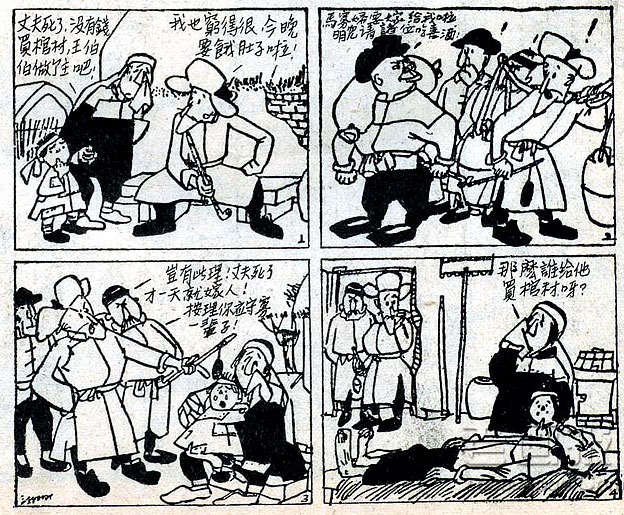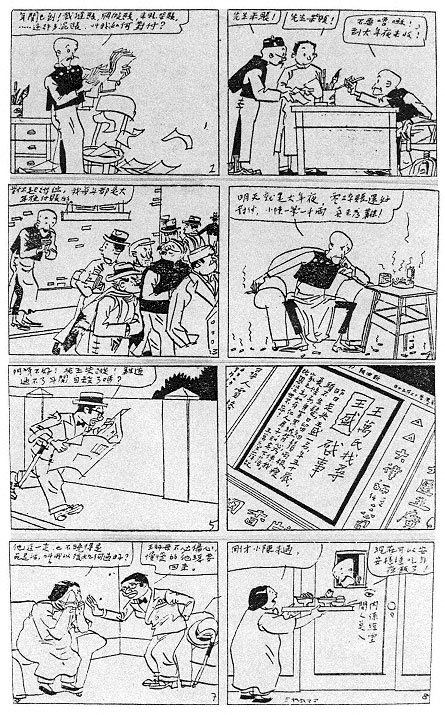Comic strip by Ye Qianyu, 1929.
Ye Qianyu was a Chinese painter, photographer and comics (manhua) legend. He was not only co-founder of Shanghai Manhua - one of the most popular Chinese comic magazines of all-time - but also the first Chinese artist to use speech balloons in his comics. He is most famous for his creation 'Mr. Wang' (1927), a gag comic starring two middle/lower class Chinese men named Mr. Wang and his sidekick Xiao Chen. As one of the most popular Chinese comics of the 1930s and 1940s, it inspired a successful movie franchise. Ye Qianyu also published various sketch books based on his travels throughout the Chinese countryside, which provide a veritable time capsule of the country during the mid and second half of the 20th century.
Early life and career
Ye Qianyu was born in 1907 in Tonglu in the Chinese province Zhejiang. His real name was Ye Lunqi. From an early age he showed talent for painting, but poverty hindered him in pursueing this profession. He nevertheless carried on and learned the craft by himself. In 1925, he moved to Shanghai, where he initially sold fabric in a shop on Nanjing Road. He designed their advertising hoardings, which attracted more shoppers. One of his graphic influences in this time period was painter Jiang Zhaohe. Illustrating novels, fashion and stage props, Qianyu also published his first comics during this decade in the journal Sanri Huabao. The magazine was forced to close down in 1927, when general Chiang Kai-shek's nationalist troops invaded Shanghai.
Shanghai Manua
No stranger to being self-reliant, Qianyu founded a comic magazine of his own: Shanghai Manua (1928-1930). He was joined by fellow artists Huang Wennong, Lu Shaofei, the Brothers Zhang (Zhang Ghuangyu and Zhang Zhenyu), Ding Song and Wang Dunqing. The men also founded a comics club, "The Shanghai Manhhua Society" in 1927 and organized the First National Cartoon Exhibition in Shanghai in 1936. After a first attempt failed, Shanghai Manua slowly but surely rose became a bestseller. Its success could be attributed to its status as the first Chinese comic magazine. Comics had appeared in previous Chinese newspapers, magazines and publications, but never in a magazine of its own.
Mr. Wang / The Alternative History of Little Chen in the Capital
One of the most popular comics in Shanghai Manhua appeared on the back cover, closing off each issue: Qianyu's 'Mr. Wang' (1927). The gag comic was inspired by George McManus' 'Bringing Up Father' and dealt with recognizable topics set in an everyday Chinese middle and lower class family. The gap-toothed Mr. Wang and his sidekick Xiao Chen always got caught up in humorous misadventures. A running gag were Wang's marital troubles, lifted directly from Mr. Jiggs in McManus' work. In 1930, Shanghai Manhua merged into a new magazine, Modern Miscelleny. Qianyu became editor, while 'Mr. Wang' continued its run.
'Mr. Wang' was so beloved in the 1930s and 1940s that it inspired no less than 11 film adaptations: 'Mr. Wang' (1934), 'Mr. Wang's Secret' (1934), 'Mr. Wang Celebrates New Year' (1935), 'Mr. Wang Visits the Countryside' (1935), 'The Biography of the Wonderful Knight Mr. Wang' (1936), 'Mr. Wang's Route to Making a Fortune' (1937), 'It's Hard for Mr. Wang to Make a Living' (1939), 'Mr. Wang and the Deputy Landlord' (1939), 'Mr. Wang and the Three Tenants' (1939), 'Mr. Wang Celebrates a Birthday' (1940) and 'Mr. Wang Visits a Funeral Parlor at Night' (1940). These comedies were amazing box-office successes and made the actor who played Wang, Tang Jie, a major star. He even started to dress and behave as his signature character in real life, going so far as to have his front teeth pulled to resemble him more. Another popular comic strip by Qianyu was 'The Alternative History of Little Chen in the Capital' (1936).
Travels and sketch books
In 1935, Qianyu had an extramarital affair with fellow comic artist Liang Baibo, whom he later married. He also enjoyed traveling and kept a sketch book, inspired by cartoonist Miguel Covarrubias. These sketch books were published as 'Sketches During My Trips' and 'Collection of Qianyu's Sketches'. Once again the magazine's lucrative business was thwarted by a military invasion. In 1937, Japan invaded China. Qianyu and his colleagues made a patriotic move and founded the "National Salvation Cartoon Propaganda Corps", which produced anti-Japanese comics and cartoons with financial support of the Chinese government. These were published in China Today, where Qianyu served as an editor. They traveled to various Chinese cities, but as Japan gradually conquered every one of them, the initiative was once again put to a halt. His comic strips 'Escape from Hong Kong' (1941) and 'Wartime Chongqing' reflected his firsthand experience of visiting these cities until they were military occupied by the Japanese army. 'Mr. Wang' also mirrored the war time period, as his character joined the army to combat the Japanese. Throughout the rest of the war, Qianyu stayed in India, where he worked as a war correspondent for the US. military forces. He published sketch books about his trip to India, titled 'An Exhibition of Drawing of Travels through India' (1943) and later one about Tibet too: 'Dajianlu Diary'.
Post-war controversy
When World War II ended in 1945, Ye Qianyu traveled to the USA, where he made a living selling his art. Back in his home country, he became a professor at the Academy of Beijing in 1947. Two years later, Mao became head of state and turned China into a Communist Republic. At first this had little negative effect on Qianyu's artistic career. He continued drawing and painting and was even appointed head of the Chinese Painting Department in 1954. However, when Mao launched his Cultural Revolution in 1966, many artists suddenly were suspected of being spies, contra-revolutionaries and enemies of the state. Qianyu's cartoons for the National Salvation Cartoon Propaganda Corps, thirty years earlier, were now interpreted as propaganda for the Chinese government before China became Communist. His work in India under the war was also used against him, following Chinese-Indian border disputes in 1962. In June 1967, the Red Guard magazine Art Storm exposed Qianyu as a "cultural secret agent for the Sino-American Cooperation Bureau". He was imprisoned for nine years and only freed in 1975. He was allowed to return to his former academy, but degraded to the function of janitor. In ill health, Qianyu suffered a heart attack in 1976 and had to undergo an operation in 1978.
Final years, death, legacy and influence
In 1979, Qianyu was rehabilitated. He became Vice President of the Research Institute of Chinese Painting in 1981 and once again became vice-chairman of the China Artists Association and a member of the National Committee. Qianyu kept drawing and painting for the remainder of his life. In 1987, he even resumed his comic career after an interlude of almost 40 years. 'Ten Years of an Absurd Dream' (1987) was an autobiographical comic which reflected his jailtime under the Cultural Revolution. He delved even further in his memories with 'An Old Brush Recalls Childhood' (1993) , which looked back at his youth. His older work was compiled, republished and exhibited, which gave him renewed public attention. In 1988, he was honored with the Golden Monkey Award for his entire career. He published his memoires and passed away in 1995.
Ye Qianyu's 'Mr. Wang' was an influence on Alfonso Wong's 'Old Master Q.'.
'Mr. Wang'.





